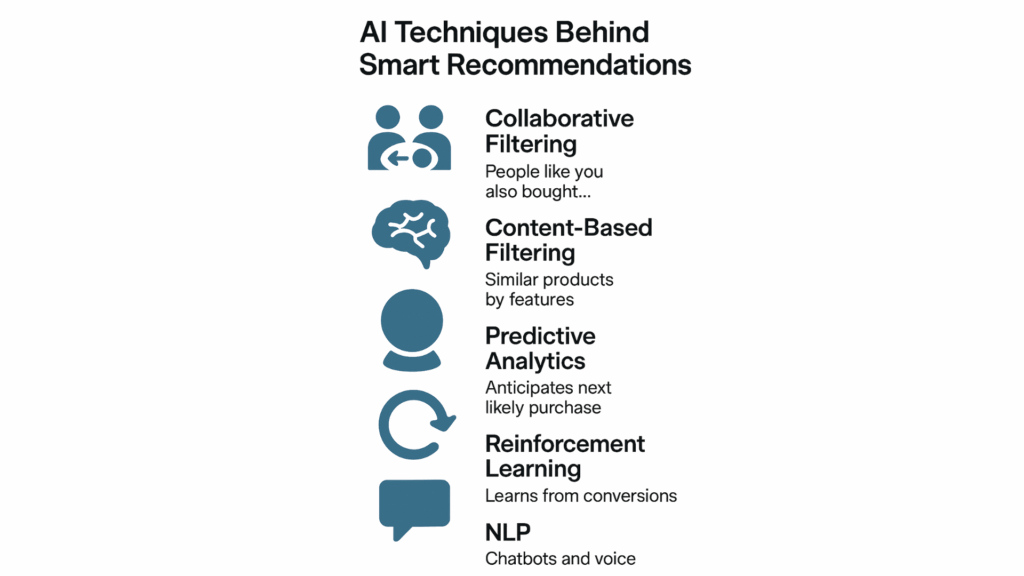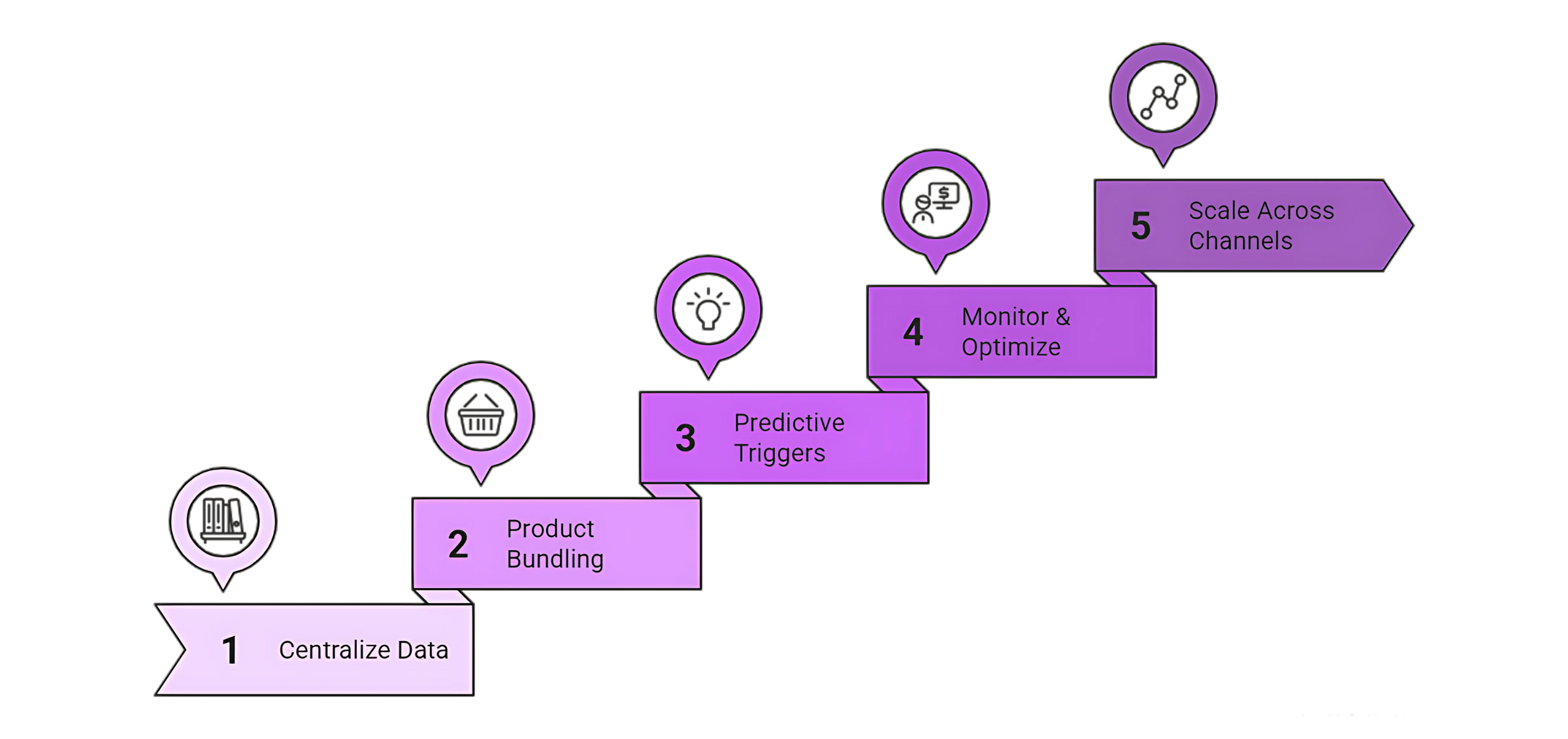In the age of hyper-personalized commerce, revenue growth is no longer just about acquiring more customers, it’s about making each customer interaction more valuable. Cross-selling and upselling have long been powerful strategies to do just that. But with AI in the mix, these tactics are evolving from generic pitches to timely, data-driven nudges that actually resonate.
In this article, we’ll explore how AI is redefining cross-selling and upselling, examine key benefits, break down the AI techniques that power them, and show how brands can implement these tactics to increase average order value (AOV), retention, and lifetime value (LTV).
Understanding Cross-Selling and Upselling in the AI Era
Before diving into the AI mechanics, let’s quickly clarify the difference:
- Cross-selling: Recommending related or complementary products (e.g., “Customers who bought this also bought…”).
- Upselling: Encouraging the purchase of a higher-end version or add-on (e.g., “Upgrade for just $10 more!”).
Traditionally, these have been rule-based or manually configured in ecommerce systems. AI now allows these tactics to become dynamic, personalized, and context-aware.
Why AI Changes the Game?
AI enables smarter, real-time decision-making by analyzing behavioral patterns, transaction history, and contextual data. Here’s how:
| Traditional Approach | AI-Powered Approach |
| Manual rules | Predictive algorithms |
| Static product bundles | Dynamic, user-specific recommendations |
| No learning from outcomes | Learns from clicks, conversions, and returns |
| Same for everyone | Personalized per user, channel, and time |
AI doesn’t just show “frequently bought together.” It predicts what will increase cart value based on who the user is and what they’re doing now.
Where AI Cross-Selling & Upselling Happens in the Customer Journey?
Let’s break it down by stage in the customer journey:
| Stage | AI-Powered Tactic Example |
| Product Discovery | Recommending bundles based on browsing history |
| Cart/Checkout | Smart upsell of a premium alternative |
| Post-Purchase | Email offer of an add-on product |
| Loyalty/Retention | Dynamic deals based on lifetime value |
AI tracks user behavior across devices and channels, creating continuity. For example, someone browsing laptops on desktop may receive a mobile push for an extended warranty later that day.
Techniques AI Uses for Cross-Selling and Upselling

1. Collaborative Filtering
AI identifies what similar users have bought together or upgraded to. Think of it as “people like you also bought…”
2. Content-Based Filtering
Here, AI looks at the attributes of the product the user is interested in and recommends others with similar or enhanced features.
3. Predictive Analytics
AI models predict which products a user is most likely to buy next based on browsing patterns, previous purchases, and engagement data.
4. Reinforcement Learning
Systems like recommendation engines learn over time which strategies convert best, optimizing offers dynamically based on real outcomes.
5. Natural Language Processing (NLP)
Used in chatbots and voice assistants, NLP can understand when a user is open to suggestions and offer contextual cross-sells mid-conversation.
Sector Deep Dive: Where It’s Working Best
- In fashion retail, AI suggests size- and style-based upsells like, “Pair this dress with these heels,” creating a natural complement at checkout.
- Electronics brands cross-sell add-ons such as chargers or cases right before purchase, increasing cart size.
- In beauty and wellness, tools like skin quizzes feed into personalized bundle suggestions tailored to the user’s profile.
- SaaS companies use AI to adjust pricing tiers dynamically based on how much or how often a user engages with the product.
- And in food delivery, real-time prompts like “Want fries with that burger?” drive impulse add-ons and elevate average ticket value.
Case Study: Amazon’s “Frequently Bought Together”
Amazon attributes around 35% of its revenue to its AI-powered recommendation systems, with “Frequently Bought Together” being one of its most effective tactics. This feature uses Collaborative filtering to analyze millions of purchase patterns and suggest relevant product bundles in real time, turning a simple $30 item into a $50+ cart with a single click.
What makes it powerful is the context-aware personalization. Suggestions adapt based on location, season, and user behavior. For example, someone buying a DSLR might be shown a tripod and memory card, while a parent browsing toys may see age-appropriate bundles. This smart bundling feels natural and helpful, not salesy, which is why it consistently drives higher average order values.
Beyond Algorithms: AI as a Revenue Strategist
What sets AI apart in modern cross-selling and upselling isn’t just automation, it’s orchestration. Today’s AI acts less like a tool and more like a strategic advisor, determining not only what to recommend, but when, how, and through which channel. This orchestration is made possible through real-time data integration across CRM, ERP, product catalogues, and customer behavior platforms.
Take for instance a returning customer who typically shops around payday. AI can analyze past transaction timing, payment methods, and even device usage to trigger a limited-time upsell offer on payday morning via mobile push, maximizing conversion probability.
These intelligent nudges are subtle but powerful. They don’t just increase AOV, they build brand affinity by showing customers that a brand “gets” them.
Personalization at Scale: Making Every Offer Feel 1:1
One of AI’s biggest advantages is scale without sacrificing personalization. Traditionally, cross-sells were limited to basic rules: “If X, then Y.” But AI enables millions of unique journeys by analyzing hundreds of micro-signals per user, like scroll depth, dwell time, cart abandonment reasons, or even sentiment in reviews and support chats.
For example:
- A skincare brand might dynamically suggest a serum based on a user’s climate (e.g., humid vs. dry), not just skin type.
- A B2B software vendor might upsell a premium plan to users who trigger specific features more frequently, like exporting reports or accessing multi-user dashboards.
Personalized cross-sells feel like service, not sales. That subtle shift can dramatically improve both the short-term transaction and long-term relationship.
Metrics That Matter: AI’s Measurable Impact
When done right, AI-led cross-selling and upselling move the needle across key performance metrics. Here’s what businesses typically see:
| Metric | AI Impact |
| Average Order Value (AOV) | Increases 10–30% with contextual offers |
| Conversion Rate | Boosts 15–25% when upsells match real-time intent |
| Customer Lifetime Value (CLV) | Grows through smarter post-purchase engagement |
| Retention | Improves when users see increasing relevance in recommendations |
AI also enables faster iteration. Marketers can test variations (e.g., upsell placement, copy, timing) and let the model self-optimize based on what’s converting, something near impossible with manual rules.
Implementation Blueprint: How to Get Started with AI Upselling
Adopting AI for upselling and cross-selling doesn’t require a full tech overhaul. Here’s a practical roadmap:

- Step 1: Centralize Your Data
Integrate customer behavior, product catalog, and purchase history into a single source of truth. - Step 2: Start Small with Product Bundling
Use AI to test dynamic bundles on popular items, then track performance. - Step 3: Add Predictive Triggers
Implement rule-based AI to begin testing upsells based on behavior (e.g., cart value, product page views). - Step 4: Monitor, Learn, Optimize
Use AI’s feedback loop, evaluate which offers drive conversion, then fine-tune timing, format, and language. - Step 5: Scale Across Channels
Once your onsite offers convert, extend to email, app, SMS, and even support chat.
AI implementation isn’t one-size-fits-all. The goal is to iterate quickly and personalize efficiently.
AI in Action: Cross-Channel Consistency
Customers don’t shop in a vacuum, they toggle between desktop, mobile, email, in-app notifications, and physical stores. AI-powered systems unify these experiences by stitching together behavior across channels and delivering cohesive recommendations.

Here’s how AI enhances channel-specific upsells:
- On-site: Personalized carousels based on real-time behavior
- Email: Abandoned cart with bundled accessory suggestion
- SMS: Flash deal on a recently browsed upgrade
- In-app: “Because you used this feature…” upsell prompt
- In-store kiosks: AI-identified bundles based on app data
This omnichannel harmony means customers encounter relevant suggestions wherever they go, with none of the jarring disconnects of traditional marketing.
Avoiding AI Overkill: Making It Feel Natural
AI recommendations that don’t feel helpful can backfire. Over-aggressive upsells may increase short-term revenue but damage long-term trust. The goal should be subtle enhancement, not constant interruption.
To keep things natural:
- Use contextual triggers (e.g., user finishes a tutorial → suggest next-level product)
- Avoid repetition (don’t keep pushing the same upgrade after refusal)
- Let users opt-out or control personalization levels
Smart AI respects customer agency. It nudges, not nags.
For example, a home goods brand using AI noted that suggesting “frequently styled with” accessories increased their rug and furniture bundle sales by over 40%, just by leveraging AI insights about aesthetics and room pairings.
Future Outlook: What’s Next in AI-Driven Upselling?
As AI evolves, we’re entering a phase of predictive anticipation, where systems won’t just respond to behavior, but anticipate it.
Emerging trends include:
- Emotion-aware recommendations: AI analyzing facial cues or voice tone to tailor suggestions (in-store or via smart assistants)
- AI-powered avatars: Virtual stylists or shopping concierges that guide users through a co-piloted journey
- Hyperlocal upselling: Inventory-aware suggestions based on warehouse location, driving faster fulfillment and better offers
We’ll also see tighter integration between AI and loyalty systems, where upsell eligibility and rewards dynamically shift based on behavior tiers or projected value.
Conclusion
AI is transforming cross-selling and upselling from static checkout tricks into dynamic, insight-driven experiences that feel both intuitive and personal. By understanding user behavior in real time, tailoring offers by channel, and learning from every interaction, AI empowers brands to increase AOV, deepen loyalty, and create value at every touchpoint.
At NoCrew, we specialize in building AI strategies that don’t just sell more, but sell smarter. If you’re ready to turn your customer journey into a revenue engine, let’s build it together. Get in touch with us.


